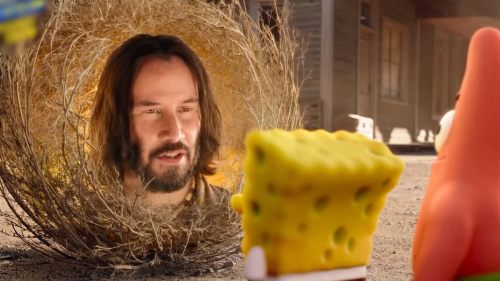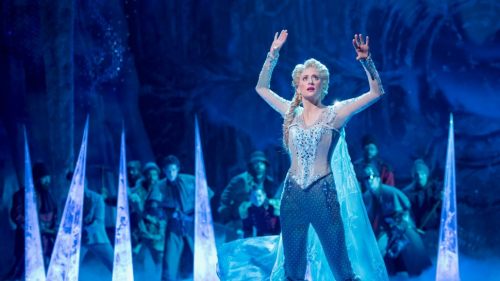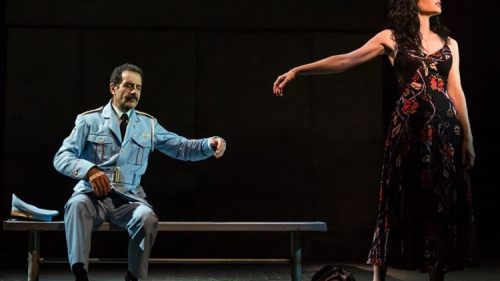SPONGEBOB SQUAREPANTS, THE BROADWAY MUSICAL: A Surreal Blast Of Joy And Optimism
Photo credit: Joan Marcus
“The world is a horrible place, SpongeBob.”
“But it’s OUR horrible place.”
Lights and billboards accost you from every direction in Times Square, so it might be hard to spot the Palace Theater’s marquee. Sandwiched between Kinky Boots and a perpetually crowded McDonald’s stands the signage for a new Broadway oddity that at first glance seems as nakedly commercial as the golden arches. The kind of gimmick you’d expect to find molded into an attraction at Disneyworld or Universal Studios. SpongeBob SquarePants is after all a children’s cartoon, despite its occasional stealthy adult innuendo, so it stands to reason that a stage musical built around a talking bath-sponge might garner skepticism, even from those of us who grew up with the series.
Well, consider this skeptic turned into an unabashed lover of Broadway’s most moving new production, an audacious blast of joy and enthusiasm that ends with a beach-ball party after earning it tenfold. SpongeBob SquarePants, The Broadway Musical isn’t just a timely surprise. It’s downright jaw-dropping.
The production is a top-to-bottom experience, and writing about it would feel incomplete without beginning the process of finding your seat. A live band dressed in floral shirts flanks one end of the stage with something akin to a Foley-studio flanking the other. Distinctly “children’s band” jazz underscores the sensation of having walked into some sort of carnival, with enormous, intricate Rube Goldberg machines dropping down from the ceiling. The sets that make up SpongeBob’s undersea city may as well have been shipped in from a kindergarten crafts class – the corals are made of solo cups and aqua-coloured pool noodles, the jellyfish are decorated umbrellas – as if the citizens of Bikini Bottom had constructed their dwellings from humanity’s discarded refuse. Before the show has even begun it’s a blast of child-like creativity, because in SpongeBob’s world, even trash can be used to build something beautiful.
The production doesn’t translate episodes of SpongeBob, but rather, it translates the sensation of watching them. Everything from the innocent to the surreal, ripe with a meta-textual intro from #1 SpongeBob fan Patchy The Pirate (“Arrrr ya ready, kids?”) right from his dedicated box seat decked out with SpongeBob merchandise. The show makes no attempts to make its lead looks remotely square (or his starfish best friend remotely star), but instead creates human versions of its fish and crustaceans with a touch of cartoonish flair. SpongeBob, the schoolboy, has yellow hair. Patrick, the slob, has pink. Brian Ray Norris’ Mr. Krabs has Hellboy-like gauntlets for pincers, while Gaving Lee’s standout Squidward Tentacles (his hair is bright green) struts on stage with an extra pair of legs. All the series’ familiars from Mrs. Puff to Old Man Jenkins to Larry the weightlifting lobster get their introductory moments, each long enough for you to recognize them through their winking design, but anything you might consider ‘fan service’ is left until the very end of the show’s surprisingly breezy two and half hours, and they each have explosive payoffs.
The story centers, as always, on SpongeBob Squarepants, absorbent, yellow, and obnoxiously enthusiastic, only it may very well be the final SpongeBob story. It deals with the end of Bikini Bottom itself, a volcanic event having been discovered to be a mere thirty-six hours away. It’s our simple fry-cook’s last chance to prove his managerial worth – only this isn’t a story about SpongeBob being the best fry-cook under the sea. In fact, that singular element that binds together perhaps the majority of the series’ best episodes finds itself entirely and intentionally absent. SpongeBob hands his signature spatula to the orchestra conductor during the opening minutes, preventing him from falling back on the one thing he’s good at. Who is SpongeBob without his job? Is he anyone at all? Anyone beyond his constant, indiscriminate, garish optimism about absolutely everything? What good is he when the world itself is about to end, and will he yield to the cynics telling him his hope in the face of certain annihilation is useless and naïve?
As the news, the radio and every conversation turn into terrified screeds and a massive doomsday clock counts down above the characters’ heads (literally; it’s part of the set design), Bikini Bottom descends into utter chaos after the repeated failure of its leadership. Amid the scramble, our eight main characters become the most extreme versions of their cartoon selves. SpongeBob (Ethan Slater) remains ever the high-pitched optimist, illuminated constantly under a golden spotlight even when the rest of the cast is lit with a wash of haunting red. Patrick Star (Danny Skinner), the town dummy, finally crawls out from under his rock (again, literal), shorts, Hawaiian shirt, blank stare and all, hoping to finally be held in some sort of high esteem for once in his life, only to be worshipped by an end-of-the-world salmon cult. No, seriously.
Their squirrel friend Sandy Cheeks (Lilli Cooper), Bikini Bottom’s only land-mammal and a martial artist with Texan charm, wants to use her scientific smarts to stop the volcano and prove she belongs in her adopted home. SpongeBob’s neighbor and co-worker Squidward, a grumpy clarinetist bogged down by the mundane weight of reality, hopes to perform once (just once!) without being interrupted, if only to prove that he can. After all, it’s what his mamma would’ve wanted. Eugene Krabs, SpongeBob’s greedy, miserly boss, does what he always does. He wants to make money money money, even if it means selling terrified customers an “Apocalypse Special” as their last burger ever. His daughter Pearl, inexplicably a sperm whale in the cartoon series, finds herself drastically changed – she wants to use her singing talents to get her father to look away from his business schemes and see her for the artist she is.
And of course, villains Sheldon J. Plankton and his “computer wife” Karen, faux heroes as always, plan out Bikini Bottom’s salvation via mass exodus while scheming to hypnotize everyone into submission. If there’s any pair of characters whose anthropomorphizing stands out, it’s the single-celled, one-eyed Plankton and his screen-on-a-stand spouse. Wesley Taylor plays Plankton as a throwback baddie, draped in a jade tunic and sporting a sinister eye-patch, while Stephanie Hsu jumps in and out of her retro-futuristic space get-up (computer screen & stand still in hand, waveform emotions and all!) as she alternates between Karen and Ensemble. Together, they burst at the seams with energy and bawdy chemistry, and Plankton even gets to lead the show’s Hip Hop segment, at one point going full-Busta Rhymes with a mile-a-minute flow as he’s backed by breakers with a severe case of the MC Hammer-pants in a number by T.I.
Musically, the show is bouncing off the walls and then some, switching from a pre-existing Bowie track (“No Control”) to original compositions from the likes of Panic! At the Disco (the introspective “Just A Simple Sponge”) to Lady Antebellum (“Chop to the Top,” in which SpongeBob and Sandy scale a volcano made of crates and ladders for a Lord of the Rings-like quest) to John Legend (“I Guess I Miss You,” a SpongeBob-Patrick duet backed by a friendship slideshow from the cartoon) to Aerosmith (“Bikini Bottom Boogie,” a rock concert on skateboards) to Plain White T's to The Flaming Lips to Sara Bareilles to Cyndi Lauper before climaxing with show-stopper “I’m Not A Loser” by They Might Be Giants, Squidward’s grandiose four-legged vaudeville tap number about finding self-worth that brought the entire audience to its feet mid-show, and it all fits because it’s all rooted in character.
To call it SpongeBob for “Trump’s America” might sound rudimentary, but that’s exactly what it is. Not only is it about keeping your head up when things get bad, it actually goes the extra mile to articulate what some of that “getting bad” looks like. Would you believe me if I told you it was charged with racial subtext, so much so that it’s basically text? Well, strap in. Sandy isn’t just the only land mammal, she’s one of only two black women in Bikini Bottom. Sandy’s life-sustaining bowl-helmet from the cartoon is now an afro, and she talks of being undervalued in the realms of both STEM and physical sport. Not only that, when the citizens of Bikini Bottom are in a state of fear and need someone to hate, she’s the first one they go after with pitchforks, and the first person to get nasty “go back to where you came from” type graffiti sprayed across her door.
The other black woman is Pearl (Jai'len Christine Li Josey), her hair styled into the very shape of the character she’s portraying. In the series, the chasm she and her father have to cross in order to connect is that of species (again: crab, sperm whale) and it’s referred to as such on stage, only it’s all too obvious what “we’re different species” means in this context when they’re standing side by side. Her father – a white businessman who really, really wants to get rich off people’s fear – refuses to see what she’s capable of, and boy oh boy, what she’s capable of is completely angelic. See, Pearl isn’t just any singer. She’s a Soul singer, and every solo she gets is a moment to behold. What’s more, the story actually follows through on these threads in ways that are uniquely satisfying, including contextualizing mere apologies for Sandy’s persecution as not being nearly enough.
Not only does the show translate the characters, it translates everything that makes SpongeBob, well… SpongeBob. It’s a cartoon come to life, with absurd visual gags like expanding limbs and even the cartoon physics of a character getting flattened to a pancake by a giant boulder – oh yeah, those giant Rube Goldberg machines? They’re used to fire giant orange balls – and it even goes so far as using a live Foley stage for cartoon sound effects (everything from footsteps to the whistle of falling objects). And yes, if you’re familiar with the show, rest assured. You will be satisfied with the gags involving the “One hour later” type title cards as they’re carried on stage by the Ensemble.
Remember the fan service I mentioned? There’s a Patrick line sure to garner applause when it arrives at an opportune moment, but the real throwback comes in the form of the show’s only pre-existing SpongeBob song, a version of “Best Day Ever” from the closing credits of the 2006 movie. Only it isn’t just fan service, nor is it used in its original context of celebrating the eponymous best day. Rather, it shows up during a moment of thematic coalescence, when doom seems all but inevitable and the need for optimism is at its most dire. SpongeBob SquarePants, the “Simple Sponge” with pretty much nothing going for him and no way to establish his worth, proves once and for all that you don’t need some kind of superpower or special skill to save the world. You can do it if you’re just an average person, because sometimes saving the world isn’t some massive, heroic feat.
Sometimes it’s bringing people together and compelling them to put aside their differences. Sometimes it’s giving them hope in a terrible situation. Sometimes it’s singing about the best day ever when you know full well that it’s been the absolute worst, and that it’s probably not going to get any better. Because sometimes optimism is the only thing left when you’ve lost everything. Sometimes that’s enough, and you’re enough when you refuse to lose it.
SpongeBob SquarePants, The Broadway Musical is currently in preview on Broadway. It opens December 4th.
Musical Production Conceived and Directed by Tina Landau
Book by Kyle Jarrow
Music Supervision, Orchestrations, and Arrangements by Tom Kitt
Choreography by Christopher Gatelli



